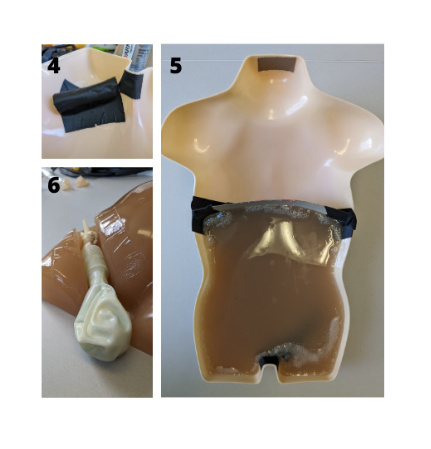Introduction
Hernias are a common occurrence in infants and children, especially those born prematurely.1 Most hernias in pediatric patients are indirect hernias, which develop from a patent processus vaginalis into which the small intestine herniates via the inguinal canal.2,3 In males, this presents as a palpable lump of herniated intestine within the scrotum.3
Although some hernias are discovered immediately after delivery, many hernias are diagnosed and treated in a primary care setting or in the emergency department. Manual reduction of indirect hernias is a first-line treatment,4 making it an important skill for emergency physicians.
Practice with training models can allow an emergency provider to feel more comfortable performing the procedure when the need arises in the emergency department. While there are full-featured models available for purchase online.5
We set out to create an economical and easily reproducible model to increase accessibility for training programs, including global health education programs. Links for materials with costs appear below. Medical educators may have access to certain materials that are medical supplies, such as Penrose drains and ultrasound gel, which will decrease the overall cost.
| Materials | Price | Link |
| 2 balloons | $8 (pack of 50) | Clear balloons |
| Disposable plastic bottle | $1 | Any regular disposable soda or water bottle works |
| Ultrasound gel | $5 | Ultrasound gel |
| 2 rubber or wooden balls | $12 (pack of 100) | Rubber Balls |
| 1”-¾” diameter silicone tubing | $25 | Silicone tubing |
| 18” length ½” diameter latex Penrose drain | $32 (box of 25) | Latex tubing
|
| 9-22mm adjustable hose clamp (optional) | $12 | Hose clamp |
| TOTAL | $95 |
Assembly
- Fold and insert one of the balloons inside the other. Any color balloon may be used, but clear balloons allow for better visualization of the simulated hernia.
- (Not pictured) Cut the plastic bottle about 2” from the opening to create a funnel.
- Attach the openings of the balloons to the cap threads of the plastic bottle funnel.
- (Not pictured) Squeeze about 20 mL of ultrasound gel into the funnel and into the inner balloon. You may need to use a stick or other object to push the gel inside.
- Put two rubber or wooden balls into the funnel and push into the inner balloon.
- (Not pictured) Detach the balloons from the funnel, tie the inner balloon and stuff the end inside the outer balloon.
- Cut a 2” piece of silicone tubing. You may choose to angle your cut to simulate the shape of the inguinal canal better.
- Pull the opening of the balloon around the piece of silicone tubing so that it is entirely within the “neck” of the balloon.
- Fill an 18” piece of latex tubing with about 20 mL of ultrasound gel and tie both ends. You may choose to tie the ends together with a third knot.
- Lubricate the silicone and latex tubing with ultrasound gel and use your finger to push the latex tubing “intestine” into the silicone tubing “inguinal canal”. You should push it in far enough for the latex tubing to be palpable within the scrotum.
- (Optional; Not pictured) Slide the hose clamp around the silicone tubing and tighten to the desired degree of difficulty. This may also be used to demonstrate incarceration of the hernia.
To increase the complexity and realism of the trainer, a pediatric ballistics gel torso and pelvis may be created using the following materials.
| Materials | Price | Link |
| Ballistics gel | $90 (entire block) | Ballistics gel |
| Crock pot | $40 | Crock pot |
| Infant mannequin body | $12 | Mannequin body |
| Gaffer tape | $20 | Gaffer tape |
| Silicone tattoo mat | $15 (pack of 8) | Silicone mat |
| TOTAL | $237 |
Assembly
- (Not pictured) Melt about ⅓ of the ballistics gel block in the crock pot until completely liquefied. It speeds the melting process to rip the gel into marble-sized pieces. The whole block is enough to make 3-4 models.
- (Not pictured) Remove the hangar from the mannequin and seal any holes with gaffer tape.
- Cut a 4-5” section of silicone tubing to create an inguinal canal and seal both openings with gaffer tape.
- Using gaffer tape, attach the silicone tubing in the anatomical position of the inguinal canal to the mannequin body as a mold for the ballistics gel. You may also create a “dam” with cardboard and gaffer tape in the mold to decrease the amount of ballistics gel required.
- Pour the ballistics gel into the mold and allow to set for 24 hours.
- Once set, take out the ballistics gel model and remove residual material from the inguinal canal area.
- (See technique section) Place the assembled inguinal canal with herniated intestine in the space for the inguinal canal and cover with a silicone mat to simulate skin.
Technique
The goal of hernia reduction is to push the small intestine back through the inguinal canal so that it is relocated entirely to the peritoneal space. To do this, place the thumb and forefinger of the non-dominant hand against the inner thigh of the model to help guide the intestines into the inguinal canal.
Use the dominant hand to locate the herniated bowel by palpating the scrotum and begin to apply pressure in the direction of the inguinal canal. Click on the link for a video demonstration:
References
- Cho YJ, Kwon H, Ha S, et al. Optimal timing for inguinal hernia repair in premature infants: surgical issues for inguinal hernia in premature infants. Ann Surg Treat Res. 2023;104(5):296-301.
- Garzi A, Prestipino M, Calabrò E, Di Crescenzo RM, Rubino MS. Laparoscopic Repair of Paediatric Indirect Inguinal Hernia: Modified Flip Flap Technique. Transl Med UniSa. 2020;22:33-37.
- Hammoud M, Gerken J. Inguinal Hernia. In: StatPearls. StatPearls Publishing; 2023.
- Abdulhai SA, Glenn IC, Ponsky TA. Incarcerated Pediatric Hernias. Surg Clin North Am. 2017;97(1):129-145.
- Hernia Model. Simulab Corporation. Accessed August 22, 2023. https://simulab.com/products/hernia-model






1 Comment
Thank Yiu